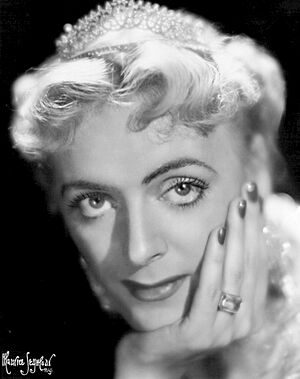Christine Jorgensen facts for kids
Quick facts for kids
Christine Jorgensen
|
|
|---|---|

Christine Jorgensen in 1954
|
|
| Born | May 30, 1926 The Bronx, New York, U.S.
|
| Died | May 3, 1989 (aged 62) San Clemente, California, U.S.
|
| Education | Mohawk Valley Community College, The Progressive School of Photography, Manhattan Medical and Dental Assistant School |
| Occupation | Actress, night club singer, recording artist |
| Known for | Pioneering gender reassignment |
| Signature | |
 |
|
Christine Jorgensen (May 30, 1926 – May 3, 1989) was an American actress, singer, recording artist, and transgender activist. A trans woman, she was the first person to become widely known in the United States for having sex reassignment surgery.
In 1945, Jorgensen was drafted into the U.S. Army during World War II. After she served as a military clerical worker, Jorgensen attended several schools, worked, and pursued a photography career. During this time, she learned about sex reassignment surgery and traveled to Europe, where in Copenhagen, Denmark, she obtained special permission to undergo a series of operations beginning in 1952.
Upon her return to the United States in the early 1950s, her transition was the subject of a New York Daily News front-page story. She became an instant celebrity, known for her directness and polished wit, and used the platform to advocate for transgender people.
Her 1967 autobiography Christine Jorgensen: A Personal Autobiography sold almost 450,000 copies. Throughout her career, she gave lectures at colleges at university on the topics of transsexuality, though she would later disassociate with the term "transsexual" and prefer the term transgender.
Early life
Jorgensen was the second child of carpenter and contractor George William Jorgensen and his wife, Florence Davis Hansen. She was named George William, after her father, when she was born. She was raised in the Belmont neighborhood of the Bronx, New York City, and baptized a Lutheran. She described herself as a "frail, blond, introverted little boy who ran from fistfights and rough-and-tumble games".
Jorgensen graduated from Christopher Columbus High School in 1945 and was soon drafted into the U.S. Army at 19. After being discharged from the Army, she attended Mohawk Valley Community College in Utica, New York; the Progressive School of Photography in New Haven, Connecticut; and the Manhattan Medical and Dental Assistant School in New York City. She also worked briefly for Pathé News.
Gender transition
Returning to New York after military service, Jorgensen heard about sex reassignment surgery. She began taking estrogen in the form of ethinylestradiol. She started researching the surgery with the help of Joseph Angelo, the husband of a classmate at the Manhattan Medical and Dental Assistant School. Jorgensen intended to go to Sweden, where the only doctors worldwide who performed the surgery were located. During a stopover in Copenhagen to visit relatives, she met Christian Hamburger, a Danish endocrinologist and specialist in rehabilitative hormonal therapy. Jorgensen stayed in Denmark and underwent hormone replacement therapy under Hamburger's direction. She chose the name Christine in honor of Hamburger.
Her parents were from Denmark, so her trip for reassignment surgery was easy to disguise as a trip to visit family. She did not relay her plan for procedures on the trip to anyone due to her concern that she would not be supported.
She obtained special permission from the Danish Minister of Justice to undergo a series of operations in Denmark. On September 24, 1951, surgeons at Gentofte Hospital in Copenhagen performed an orchiectomy on Jorgensen. In a letter to friends on October 8, 1951, she referred to how the surgery affected her:
As you can see by the enclosed photos, taken just before the operation, I have changed a great deal. But it is the other changes that are so much more important. Remember the shy, miserable person who left America? Well, that person is no more and, as you can see, I'm in marvelous spirits.
In a 1980s Hour Magazine interview with Gary Collins, Jorgensen described her family's acceptance:
My family were very understanding. They had a choice; I gave them only one choice. Either they were to accept me or there was a break. My family did not want to lose me, and I was very close with [my mother and father] until they died.
Publicity
Jorgensen was publicly outed when her letter to her parents in New York leaked to the press. She had planned to keep her transition a secret but she was forcefully outed by the New York Daily News. Her letter stated, "Nature made a mistake which I have had corrected, and now I am your daughter."
The New York Daily News ran a front-page story on December 1, 1952, under the headline "Ex-GI Becomes Blonde Beauty", announcing (incorrectly) that Jorgensen had become the recipient of the first "sex change." In reality, German doctors had performed this type of surgery in the late 1920s and early 1930s; Dorchen Richter and Danish artist Lili Elbe, both patients of Magnus Hirschfeld, were known recipients of such operations.
After her surgeries, Jorgensen originally stated that she wanted a quiet life of her design. However, upon returning to the United States, she could only earn a living by making public appearances. Jorgensen was an instant celebrity when she returned to New York in February 1953. A large crowd of journalists met her as she came off her flight, and despite the Danish royal family being on the same flight, the audience largely ignored them in favor of Jorgensen. Soon after her arrival, she launched a successful nightclub act and appeared on television, radio, and theatrical productions. The first five-part authorized account of her story was written by herself in a February 1953 issue of The American Weekly, titled "The Story of My Life." In 1967, she published her autobiography, Christine Jorgensen: A Personal Autobiography, which sold almost 450,000 copies.
In the wake of her transition, part of the media coverage debated her original gender identity, many claiming that she was never fully male. This theory was also used to downplay the importance of Jorgensen's transition, with doctors claiming that her surgeries were "far from a medical rarity... [with] similar cases in hospitals all over the U.S.". Others insisted that Jorgensen's pre-transition body was clearly male and the surgeries were not to mend a physical abnormality, but rather align her gender with her physical sex. The overwhelming amount of coverage opened new discussions surrounding gender and transexuals.
According to a 1985 publication, Jorgensen opposed the word "transsexual". She stated, "I am a transgender because gender refers to who you are as a human."
Later life
Jorgensen planned to marry labor union statistician John Traub, but the engagement was called off. In 1959 she announced her engagement to typist Howard J. Knox in Massapequa Park, New York, where her father built her a house after reassignment surgery. She and Knox settled down and joined a Lutheran church. However, the couple was unable to obtain a marriage license because Jorgensen's birth certificate listed her as male. In a report about the broken engagement, The New York Times reported that Knox had lost his job in Washington, D.C. when his engagement to Jorgensen became known.
After her parents died, Jorgensen moved to California in 1967. She left behind the ranch home built by her father in Massapequa and settled at the Chateau Marmont in Los Angeles. During this same year, Jorgensen published her autobiography, Christine Jorgensen: A Personal Autobiography, which chronicled her life experiences as a transgender woman and included her perspectives on some of her significant life events. In her autobiography, Jorgensen revealed her struggles with depression. She explained how her mental health deteriorated.
During the 1970s and 1980s, Jorgensen toured university campuses and other venues to speak about her experiences. She was known for her directness and polished wit. She once demanded an apology from Vice President Spiro T. Agnew when he called Charles Goodell "the Christine Jorgensen of the Republican Party." Agnew refused her request.
Jorgensen also worked as an actress and nightclub entertainer and recorded several songs. In summer stock, she played Madame Rosepettle in the play Oh Dad, Poor Dad, Mamma's Hung You in the Closet and I'm Feelin' So Sad.
Circa 1958, while she was performing at the Latin Quarter in New York, she saw the 1958 musical Flower Drum Song on Broadway. There, she saw Pat Suzuki perform "I Enjoy Being a Girl," which shortly became Jorgensen's "theme song." Jorgensen included the song in her nightclub act, incorporating a quick-change into a Wonder Woman costume.
Warner Communications, owners of the Wonder Woman character's copyright, demanded she quit using the character. She did so, using instead a new character of her invention, Superwoman, who was marked by the inclusion of a large letter S on her cape. Jorgensen continued her act, performing at Freddy's Supper Club on the Upper East Side of Manhattan until at least 1982 when she performed twice in the Hollywood area: once at the Backlot Theatre, adjacent to the discothèque Studio One, and later at The Frog Pond restaurant. The performance was recorded and made available as an album on iTunes. In 1984, Jorgensen returned to Copenhagen to perform her show and was featured in Teit Ritzau's Danish transgender documentary film Paradiset er ikke til salg (Paradise Is Not for Sale). Jorgensen was the first and only known trans woman to perform at Oscar's Delmonico Restaurant in downtown New York, for which owners Oscar and Mario Tucci received criticism.
She died of bladder and lung cancer on May 3, 1989, at age 62. Her ashes were scattered off Dana Point, California.
Legacy
Jorgensen's highly publicized transition helped bring to light gender identity and shaped a new culture of more inclusive ideas about the subject. As a transgender spokesperson and public figure, she influenced other transgender people to change their sex and names on their birth certificates.
In 2012, Jorgensen was inducted into Chicago's Legacy Walk, an outdoor public display celebrating LGBT history and people.
In 2014, Jorgensen was one of the inaugural honorees in the Rainbow Honor Walk, a walk of fame in San Francisco's Castro neighborhood, noting LGBTQ people who have "made significant contributions in their fields".
In June 2019, Jorgensen was one of the inaugural 50 American "pioneers, trailblazers, and heroes" included on the National LGBTQ Wall of Honor within the Stonewall National Monument (SNM) in New York City's Stonewall Inn. The SNM is the first U.S. national monument dedicated to LGBTQ rights and history, and the wall's unveiling was timed to take place during the 50th anniversary of the Stonewall riots.
See also
- April Ashley, second publicized British citizen to undergo SRS
- Coccinelle, first publicized French citizen to undergo SRS
- Roberta Cowell, first publicized British citizen to undergo SRS
- Lili Elbe, first publicized Danish citizen to undergo SRS
- Charlotte Frances McLeod, second American woman to undergo SRS in Denmark
- Maryam Khatoon Molkara, first publicized Iranian citizen to undergo SRS
- Renee Richards, competed on the men's professional tennis circuit in the 1970s, and became widely known following male-to-female SRS, when she fought to compete as a woman in the 1976 US Open



